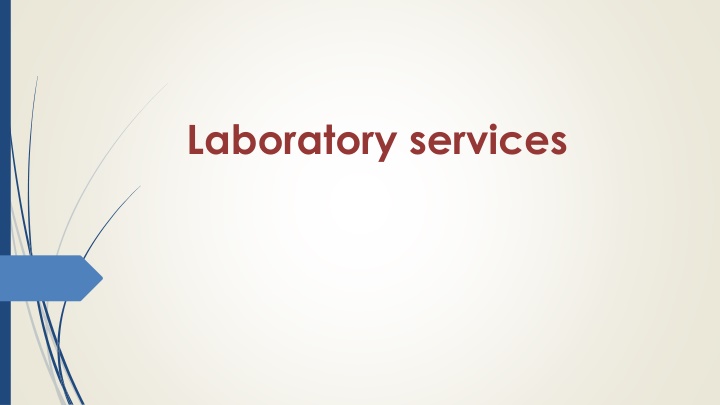
Role of Laboratory Services in Disease Diagnosis and Treatment
"Learn about the vital role of laboratory services in detecting, diagnosing, and treating diseases through diagnostic tests, identifying organisms, blood cell analysis, immunological tests, and DNA analysis. Explore the importance of lab equipment and management in ensuring accurate and efficient testing processes."
Download Presentation

Please find below an Image/Link to download the presentation.
The content on the website is provided AS IS for your information and personal use only. It may not be sold, licensed, or shared on other websites without obtaining consent from the author. If you encounter any issues during the download, it is possible that the publisher has removed the file from their server.
You are allowed to download the files provided on this website for personal or commercial use, subject to the condition that they are used lawfully. All files are the property of their respective owners.
The content on the website is provided AS IS for your information and personal use only. It may not be sold, licensed, or shared on other websites without obtaining consent from the author.
E N D
Presentation Transcript
A medical laboratory is a place where tests are done on samples to get information about a patient's heath. Laboratory services include testing materials, tissues, or fluids obtained from a patient or clinical studies to determine the cause and nature of the disease. Laboratory services play a critical role in detecting, diagnosing, and treating disease. Samples are collected, and examination and analysis of body fluids, tissue, and cells.
The main services are: To perform diagnostic tests To identify organisms, like E. coli bacteria To count and classify blood cells to identify infection or disease To perform immunological tests to check for antibodies To match blood samples for transfections To analyze DNA
Lab equipment and LIS Planning for equipment Basic instruments and equipment should be made available. All vital equipment should be in duplicate or have an alternative arrangement. Selecting the best instrument for the laboratory is a very important part of equipment management.
Follow elements should be considered during the management program in the lab
Lab equipment Basic equipment for all types of routine investigations are: A centrifuge is a laboratory device used to separate liquids based on their density. A water bath is a device made of a metal bowl, most likely filled with hot water. It is used to incubate samples in water at a constant temperature for a long time. It is also used to heat reagents, dissolve some materials, and incubate environments. A microscopeis a device for enlarging small things that cannot be seen with the naked eye or showing the fine details of objects to discover their composition and study.
An autoclave is a metal pressure tank designed to heat aqueous solutions above their boiling point at standard atmospheric pressure for sterilization. A pH meter is an instrument used to measure a specific liquid's pH (pH or basic level). An incubator is a device used to grow and maintain microbial colonies or a cell colony. Balance is used to measure the mass of objects and chemicals with very great accuracy
Other tools and glassware used in the laboratory Standard flask It has a neck engraved with a sign (__) in the form of a circular line indicating the extent to which the surface of the liquid should reach, and there is a written indication of the size of the vessel. Burette A graduated glass tube, at the bottom end of which is a plunger glass spout. Various sizes are intended to be taken out The conical flask The solution is transferred to it by the pipette. Easy to move. It is used to prepare, preserve, and measure chemicals and solutions. Beaker It is a vessel used to stir, mix, and mix liquids in chemical laboratories. A test tube is a glass laboratory instrument with an opening from the top used to pour, transport, or mix solutions, chemicals, and liquids
Lab Information System )LIS( A lab information system (LIS) is a class of software that receives processes, and stores information generated by medical laboratory processes. These systems often must interface with instruments and other information systems such as hospital information systems (HIS). A LIS is a highly configurable application customized to facilitate a wide variety of laboratory workflow.
Three main components: Sample Tracking, Protocol Execution, and Storage Organization. A laboratory information system (LIS) is a healthcare software solution that processes, stores and manages patient data related to laboratory processes and testing. The main advantages of LIS are: reduced clerical work, better evaluation of workload, faster communication, improvement of information given to the clinician: adapted reference values, interpretation, comments, improved retrieval operations, and faster billing.






















